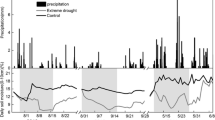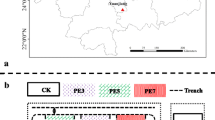Abstract
Extreme weather events have played an important role in driving the ecosystem dynamics in high altitude areas, but the underlying mechanism remains unclear. To understand if and how the soil processes of an ecosystem react to extreme drought, we manipulated a once-in-a-century meteorological extreme drought in an alpine meadow on the Tibetan Plateau, which is also known as the “forerunner of global weather changes”. The extremity was determined by statistical extreme weather events with respect to a historical reference period from April to September during 1962–2004, where the local historical precipitation data was calculated and intensified to 100-year recurrent drought event with Gumbel I distribution. The indicators we measured included soil microbial biomass C/N/P and soil enzymatic activities of phosphatase (AP) disbounding organic phosphate, cellobiohydrolase (CBH), β-glucocidase (BG), N-releasing enzyme N-acetylglucosaminidase (NAG) as well as soil respirations, during and after the treatments. It was found that the manipulated event induced a rapid shift in microbial biomass and activities, indicating a lower resistance of the underground process. However, the microbial and biochemical parameters saw rapid recovery after the event, which meant the soil processes enjoyed high resilience. The high responsiveness and lag-time effects of the soil indicators rendered new horizons for us to evaluate the interaction between the extremes and the ecosystem stability. Our study indicated that the once-in-a-century extreme drought induced very short term response in the soil biotic process, and the soil processes worked to buffer against such events under the observation period.
Similar content being viewed by others
References
Aanderud ZT, Richards JH, Svejcar T, et al. (2010) A shift in seasonal rainfall reduces soil organic carbon storage in a cold desert. Ecosystems 13(5): 673–682. DOI: 10.1007/s10021-010-9346-1
Beier C, Beierkuhnlein C, Wohlgemuth T, et al. (2012) Precipitation manipulation experiments - challenges and recommendations for the future. Ecology Letter 15(8): 899–911. DOI: 10.1111/j.1461-0248.2012.01793.x
Borken W, Matzner E (2009) Reappraisal of drying and wetting effects on C and N mineralization and fluxes in soils. Global Change Biology 15(4): 808–824. DOI: 10.1111/j.1365-2486.2008.01681.x
Bray RH, Kurtz LT (1945) Determination of total, organic, and available forms of phosphorus in soils. Soil Science 59(1): 39–45. DOI: 10.1097/00010694-194501000-00006
Breda N, Huc R, Granier A, et al. (2006) Temperate forest trees and stands under severe drought: a review of ecophysiological responses, adaptation processes and long-term consequences. Annals of Forest Science 63(6): 625–644. DOI: 10.1051/forest:2006042
Brookes PC, Landman A, Pruden, et al. (1985) Chloroform fumigation and the release of soil-nitrogen - a rapid direct extraction method to measure microbial biomass nitrogen in soil. Soil Biolology and Biochemistry 17(6): 837–842. DOI: 10.1016/0038-0717(85)90144-0
Carpenter SR, Millennium Ecosystem Assessment (Program), Scenarios Working Group (2005) Ecosystems and human well-being: scenarios, volume 2: findings of the Scenarios Working Group of the Millennium Ecosystem Assessment. Island Press, Washington, DC.
Chinese Soil Taxonomy Research Group (1995) Chinese Soil Taxonomy. Science Press, Beijing. pp. 58–147 (in Chinese).
D’Angelo E, Crutchfield J, Vandiviere M (2001) Rapid, sensitive, microscale determination of phosphate in water and soil. Journal of Environment Quality 30(6): 2206–2209.
De Boeck HJ, Dreesen FE, Janssens IA, et al. (2011) Wholesystem responses of experimental plant communities to climate extremes imposed in different seasons. New Phytologist, 189(3): 806–817. DOI: 10.1111/j.1469-8137.2010.03515.x
Devi NB, Yadava PS (2006) Seasonal dynamics in soil microbial biomass C, N and P in a mixed-oak forest ecosystem of Manipur, North-east India. Applied Soil Ecology 31(3): 220–227. DOI: 10.1016/j.apsoil.2005.05.005
Doane TA, Horwath WR (2003) Spectrophotometric determination of nitrate with a single reagent. Analytical Letters 36(12): 2713–2722. DOI: 10.1081/AL-120024647
Duniway MC, Herrick JE, Monger HC (2010) Spatial and temporal variability of plant-available water in calcium carbonate-cemented soils and consequences for arid ecosystem resilience. Oecologia 163(1): 215–226. DOI: 10.1007/s00442-009-1530-7
Easterling DR, Meehl GA, Parmesan C, et al. (2000) Climate extremes: Observations, modeling, and impacts. Science 289(5487): 2068–2074. DOI: 10.1126/science.289.5487.2068
Fang KY, Gou XH, Chen FH, et al. (2010) Reconstructed droughts for the Southeastern Tibetan Plateau over the past 568 years and its linkages to the Pacific and Atlantic Ocean climate variability. Climate Dynamics 35(4): 577–585. DOI: 10.1007/s00382-009-0636-2
Godfree R, Lepschi B, Reside A, et al. (2011) Multiscale topoedaphic heterogeneity increases resilience and resistance of a dominant grassland species to extreme drought and climate change. Global Change Biology 17(2): 943–958. DOI: 10.1111/j.1365-2486.2010.02292.x
Griffiths BS, Bonkowski M, Roy J, et al. (2001) Functional stability, substrate utilization and biological indicators of soils following environmental impacts. Applied Soil Ecology 16(1): 49–61. DOI: 10.1016/S0929-1393(00)00081-0
Griffiths BS, Ritz K, Bardgett RD, et al.(2000) Ecosystem response of pasture soil communities to fumigation-induced microbial diversity reductions: an examination of the biodiversity-ecosystem function relationship. Oikos 90(2): 279–294. DOI: 10.1034/j.1600-0706.2000.900208.x
Gumbel EJ (1958) Statistics of extremes. Columbia University Press, New York. pp 340–375.
Harper CW, Blair JM, Fay PA, et al. (2005) Increased rainfall variability and reduced rainfall amount decreases soil CO2 flux in a grassland ecosystem. Global Change Biology 11(2): 322–334. DOI: 10.1111/j.1365-2486.2005.00899.x
Hueso S, Hernandez T, Garcia C (2011) Resistance and resilience of the soil microbial biomass to severe drought in semiarid soils: The importance of organic amendments. Appllied Soil Ecology 50: 27–36. DOI: 10.1016/j.apsoil.2011.07.014
International Society of Soil Science, International Soil Reference and Information Centre and Food, Organization of the United Nations (1998) World reference base for soil resources, food and agriculture organizaiton of the United Nations.
Jensen KD, Beier C, Michelsen A, et al. (2003) Effects of experimental drought on microbial processes in two temperate heathlands at contrasting water conditions. Applied Soil Ecology, 24(2): 165–176. DOI: 10.1016/S0929-1393(03)00091-X
Jentsch A, Kreyling J, Elmer M, et al. (2011) Climate extremes initiate ecosystem-regulating functions while maintaining productivity. Journal of Ecology 99(3): 689–702. DOI: 10.1111/j.1365-2745.2011.01817.x
Jiang ZH, Song J, Li L, et al. (2012) Extreme climate events in China: IPCC-AR4 model evaluation and projection. Climatic Change 110(1–2): 385–401. DOI: 10.1007/s10584-011-0090-0
Jimenez MA, Jaksic FM, Armesto JJ, et al. (2011) Extreme climatic events change the dynamics and invasibility of semiarid annual plant communities. Ecology Letters 14(12): 1227–1235. DOI: 10.1111/j.1461-0248.2011.01693.x
Joos O, Hagedorn F, Heim A, et al. (2010) Summer drought reduces total and litter-derived soil CO2 effluxes in temperate grassland - clues from a C-13 litter addition experiment. Biogeosciences 7(3): 1031–1041.
Körner C (2003) Alpine plant life: functional plant ecology of high mountain ecosystems. Springer Press, Berlin.
Kahmen A, Perner J, Buchmann N (2005) Diversity-dependent productivity in semi-natural grasslands following climate perturbations. Functional Ecology 19(4): 594–601. DOI: 10.1111/j.1365-2435.2005.01001.x
Kato T, Tang YH, Gu S, et al. (2006) Temperature and biomass influences on interannual changes in CO2 exchange in an alpine meadow on the Tibetan Plateau. Global Change Biology 12(7): 1285–1298. DOI: 10.1111/j.1365-2486.2006.01153.x
Kirschbaum MUF (1995) The tempreature-dependence of soil organic-matter decomposition, and the effect of global warning on soil organic-c storage. Soil Biology & Biochemistry 27(6): 753–760. DOI: 10.1016/0038-0717(94)00242-S
Lewis SL, Malhi Y, Phillips OL (2004) Fingerprinting the impacts of global change on tropical forests. Philosophical Transactions of the Royal Society of London Series B-Biological Sciences, 359(1443): 437–462. DOI: 10.1098/rstb.2003.1432
Lipson DA, Schmidt SK, Monson RK (1999) Links between microbial population dynamics and nitrogen availability in an alpine ecosystem. Ecology 80(5): 1623–1631. DOI: 10.1890/0012-9658(1999)080[1623:LBMPDA]2.0.CO;2
Liu XH, Shao XM, Wang LL, et al. (2008) Response and dendroclimatic implications of delta(13)C in tree rings to increasing drought on the Northeastern Tibetan Plateau. Journal of geophysical research-biogeosciences 113(G3). DOI: 10.1029/2007JG000610
Mcnaughton SJ (1993) Biodiversity and function of grazing ecosystems. Biodiversity and Ecosystem Function, 99: 361–383.
Panikov NS (1999) Understanding and prediction of soil microbial community dynamics under global change. Appllied Soil Ecology 11(2–3): 161–176. DOI: 10.1016/S0929-1393(98)00143-7
Penuelas J, Prieto P, Beier C, et al. (2007) Response of plant species richness and primary productivity in shrublands along a north-south gradient in Europe to seven years of experimental warming and drought: reductions in primary productivity in the heat and drought year of 2003. Global Change Biology 13(12): 2563–2581. DOI: 10.1111/j.1365-2486.2007.01464.x
Petrone RM, Price JS, Carey SK, et al. (2004) Statistical characterization of the spatial variability of soil moisture in a cutover peatland. Hydrological Processes 18(1): 41–52. DOI: 10.1002/hyp.1309
Rey A, Pegoraro E, Tedeschi V, et al. (2002) Annual variation in soil respiration and its components in a coppice oak forest in Central Italy. Global Change Biology 8(9): 851–866. DOI: 10.1046/j.1365-2486.2002.00521.x
Rhine ED, Sims GK, Mulvaney RL, et al. (1998) Improving the Berthelot reaction for determining ammonium in soil extracts and water. Soil Science Society of America Journal 62(2): 473–480.
Rich PM, Breshears DD, White AB (2008) Phenology of mixed woody-herbaceous ecosystems following extreme events: Net and differential responses. Ecology 89(2): 342–352. DOI: 10.1890/06-2137.1
Scheffer M, Carpenter S, Foley JA, et al. (2001) Catastrophic shifts in ecosystems. Nature 413(6856): 591–596. DOI: 10.1038/35098000
Schmitt A, Glaser B (2011) Organic matter dynamics in a temperate forest soil following enhanced drying. Soil Biology & Biochemistry 43(3): 478–489. DOI: 10.1016/j.soilbio.2010.09.037
Sinsabaugh RL, Antibus RK, Linkins AE (1993) Wood decomposition-nitrogen and phosphorus dynamics in relation to extracellular enzyme-activity. Ecology 74(5): 1586–1593. DOI: 10.2307/1940086
Sowerby A, Emmett B, Beier C, et al. (2005) Microbial community changes in heathland soil communities along a geographical gradient: interaction with climate change manipulations. Soil Biology & Biochemistry 37(10): 1805–1813. DOI: 10.1016/j.soilbio.2005.02.023
Tobor-Kaplon MA, Bloem J, Romkens P, et al. (2005) Functional stability of microbial communities in contaminated soils. Oikos 111(1): 119–129.
van Meeteren MM, Tietema A, van Loon EE, et al. (2008) Microbial dynamics and litter decomposition under a changed climate in a Dutch heathland. Applied Soil Ecology 38(2): 119–127. DOI: 10.1111/j.0030-1299.2005.13512.x
Vance ED, Brookes PC, Jenkinson DS (1987) An extraction method for measuring soil microbial biomass-C. Soil Biology & Biochemistry 19(6): 703–707. DOI: 10.1016/j.apsoil.2007.09.006
White PS, Jentsch A (2001) The search for generality in studies of disturbance and ecosystem dynamics. Progress in Botany 62: 399–450.
Yuste JC, Penuelas J, Estiarte M, et al. (2011) Drought-resistant fungi control soil organic matter decomposition and its response to temperature. Global Change Biology 17(3): 1475–1486. DOI: 10.1111/j.1365-2486.2010.02300.x
Zhao L, Li Y, Xu S, et al. (2006) Diurnal, seasonal and annual variation in net ecosystem CO2 exchange of an alpine shrubland on the Tibetan Plateau. Global Change Biology 12(10): 1940–1953. DOI: 10.1111/j.1365-2486.2006.01197.x
Zhou XH, Talley M, Luo YQ (2009) Biomass, litter, and soil respiration along a precipitation gradient in southern great plains, USA. Ecosystems 12(8): 1369–1380. DOI: 10.1111/j.1365-2486.2006.01197.x
Author information
Authors and Affiliations
Corresponding authors
Rights and permissions
About this article
Cite this article
Wang, Zy., Sun, G., Luo, P. et al. A study of soil-dynamics based on a simulated drought in an alpine meadow on the Tibetan Plateau. J. Mt. Sci. 10, 833–844 (2013). https://doi.org/10.1007/s11629-013-2697-2
Received:
Accepted:
Published:
Issue Date:
DOI: https://doi.org/10.1007/s11629-013-2697-2




